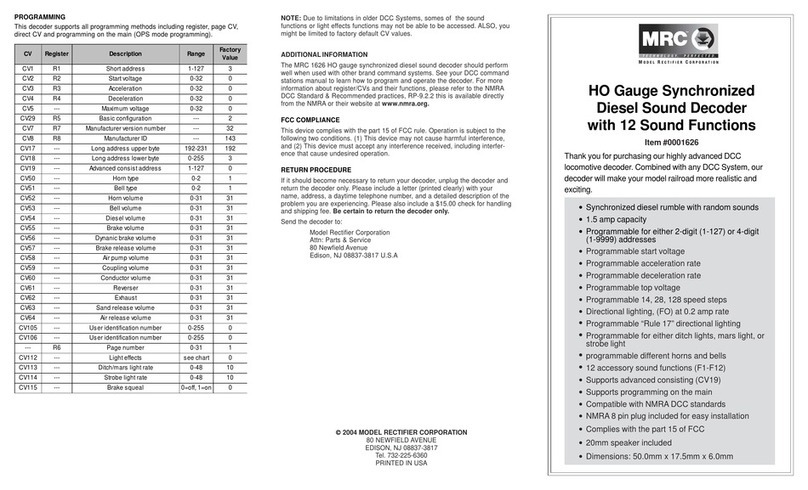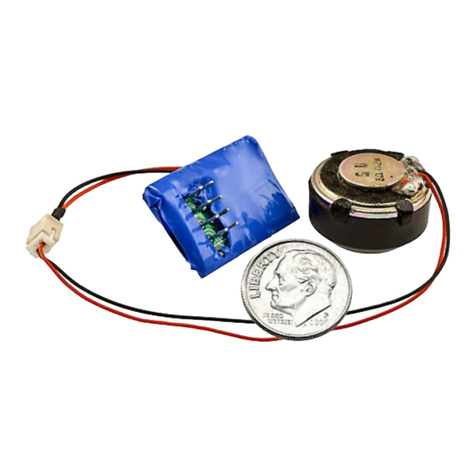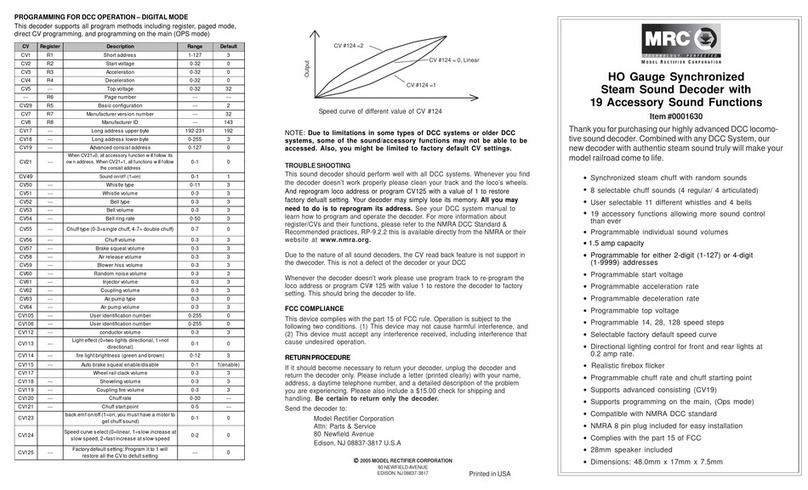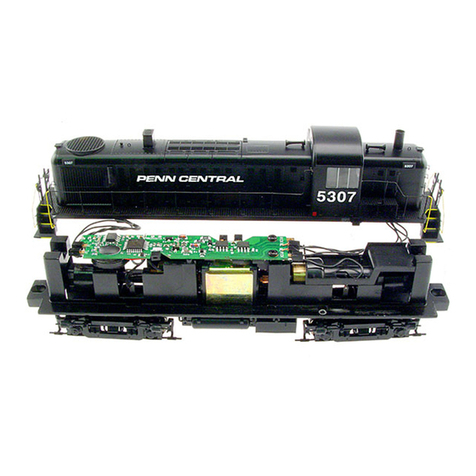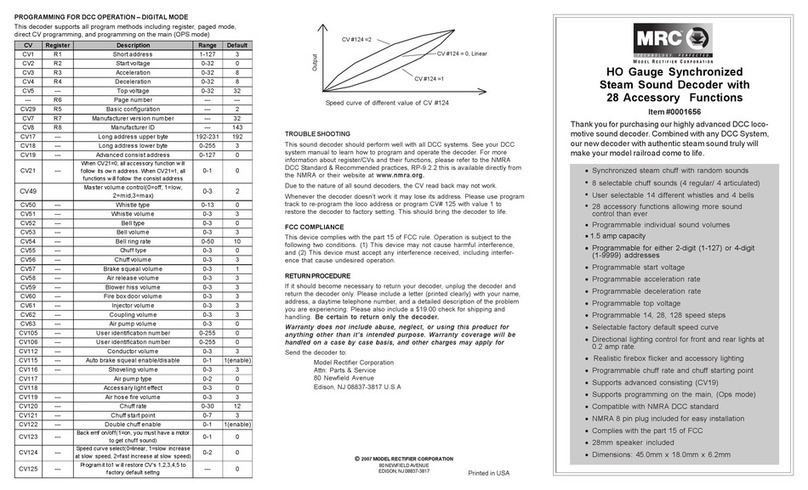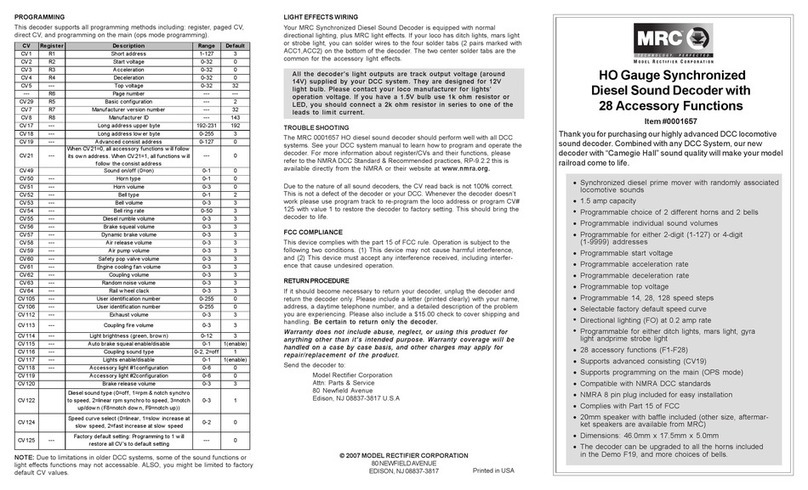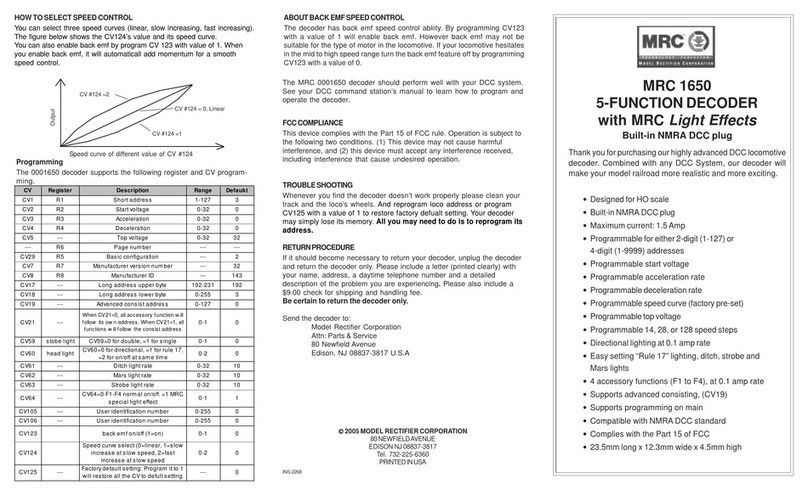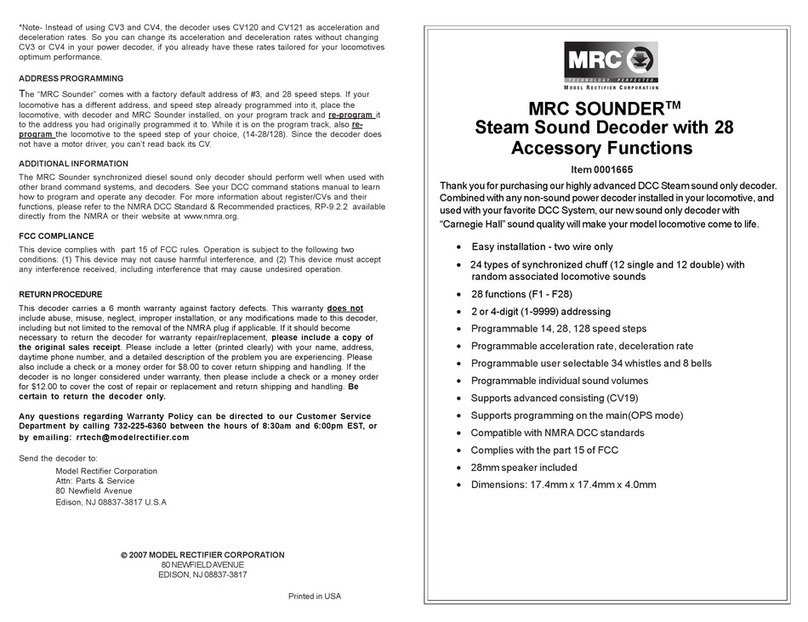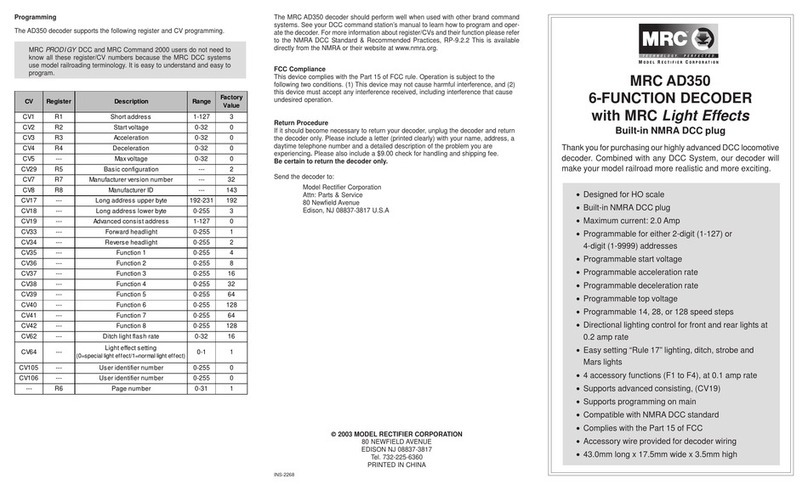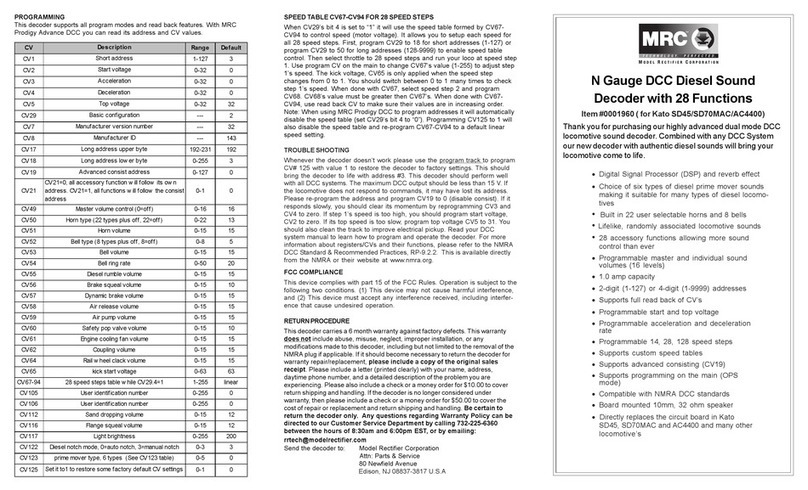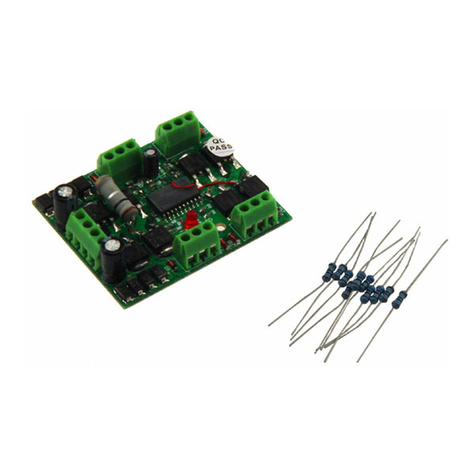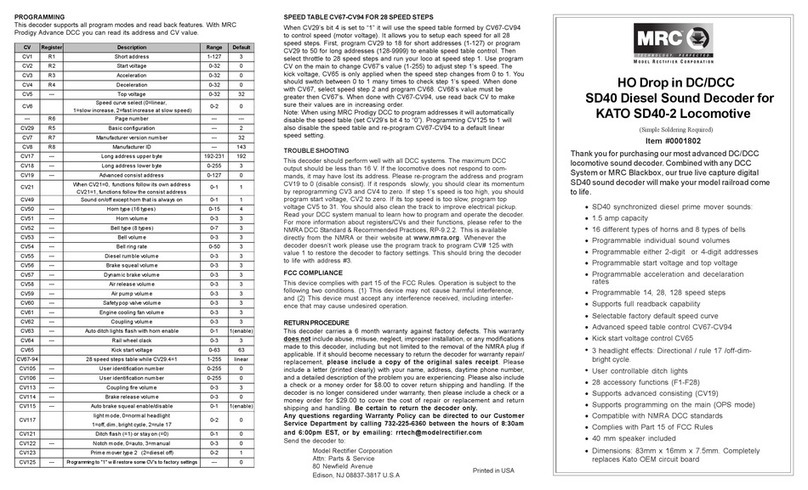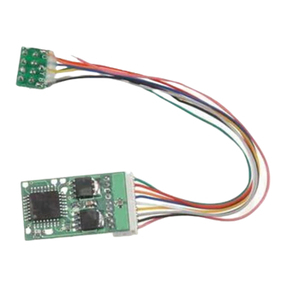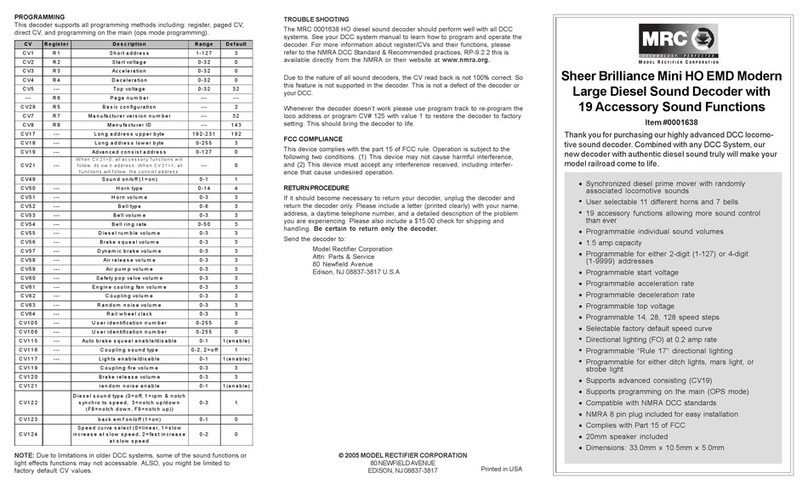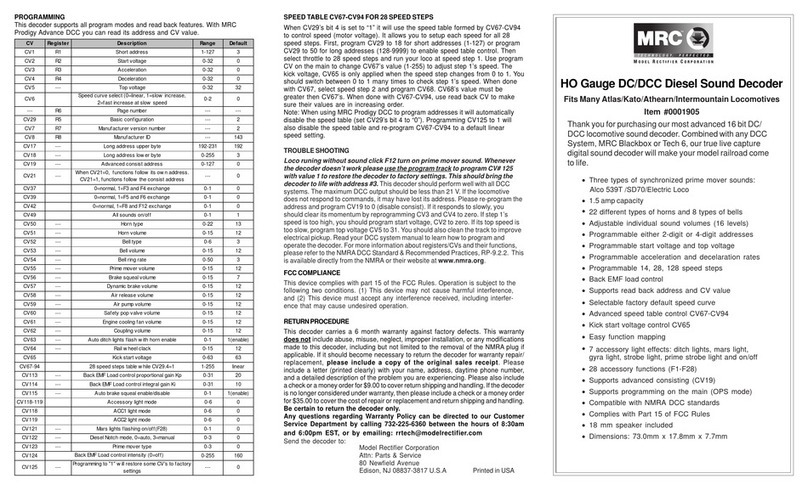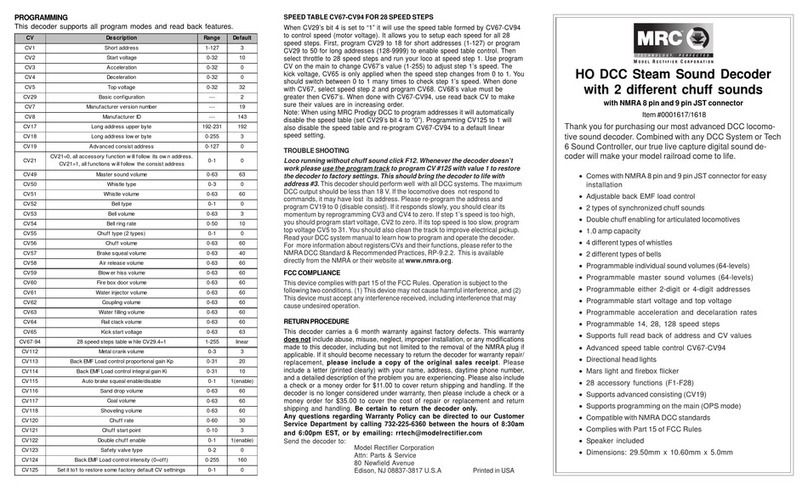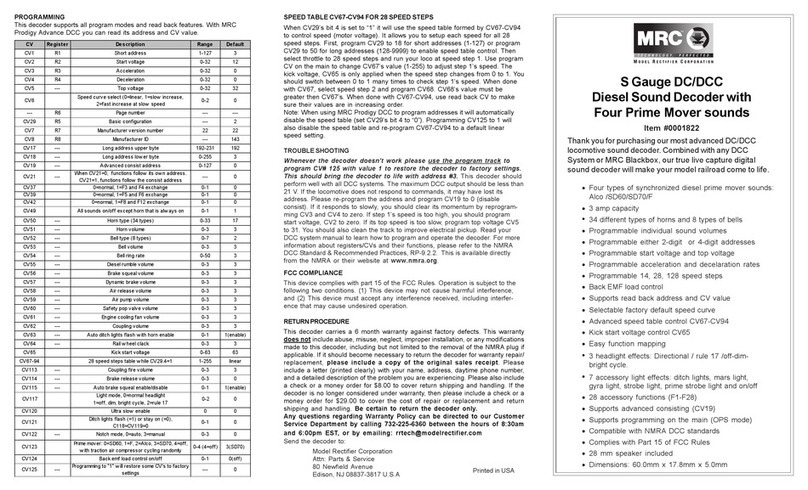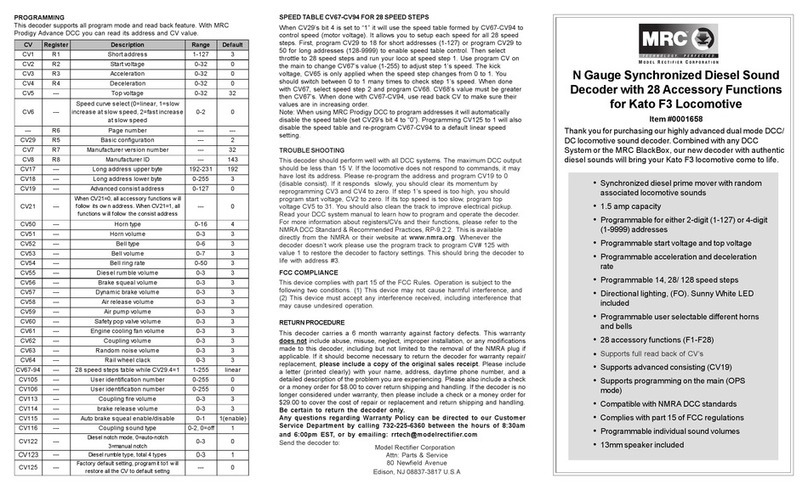
G Gauge DC/DCC
Steam Sound Decoder with
12 different chuff sounds
Item #0001819
Thank you for purchasing our most advanced DC/DCC
locomotive sound decoder. Combined with any DCC
System or the MRC Blackbox, our true live capture digital
sound decoder will make your model railroad come to life.
•Twelve types of synchronized chuff sounds
•Double chuff enabling
•5 amp capacity
•34 different types of whistles and 8 types of bells
•Programmable individual sound volumes
•Programmable either 2-digit or 4-digit addresses
•Programmable start voltage and top voltage
•Programmable acceleration and decelaration rates
•Programmable 14, 28, 128 speed steps
•Supports full read back of address and CV values
•Selectable factory default speed curve
•Advanced speed table control CV67-CV94
•Kick start voltage control CV65
•Directional Head lights
•Mars light and firebox flicker
•28 accessory functions (F1-F28)
•Supports full read back of CV’s
•Supports advanced consisting (CV19)
•Supports programming on the main (OPS mode)
•Compatible with NMRA DCC standards
•Complies with Part 15 of FCC Rules
•40 mm speaker included
•Dimensions: 70.5mm x 34.0mm x 11.4mm
PROGRAMMING
This decoder supports all program modes and read back features. With MRC
Prodigy Advance DCC you can read its address and all CV values.
Printed in USA
SPEED TABLE CV67-CV94 FOR 28 SPEED STEPS
When CV29’s bit 4 is set to “1” it will use the speed table formed by CV67-CV94
to control speed (motor voltage). It allows you to setup each speed for all 28
speed steps. First, program CV29 to 18 for short addresses (1-127) or program
CV29 to 50 for long addresses (128-9999) to enable speed table control. Then
select throttle to 28 speed steps and run your loco at speed step 1. Use program
CV on the main to change CV67’s value (1-255) to adjust step 1’s speed. The
kick voltage, CV65 is only applied when the speed step changes from 0 to 1. You
should switch between 0 to 1 many times to check step 1’s speed. When done
with CV67, select speed step 2 and program CV68. CV68’s value must be
greater then CV67’s. When done with CV67-CV94, use read back CV to make
sure their values are in increasing order.
Note: When using MRC Prodigy DCC to program addresses it will automatically
disable the speed table (set CV29’s bit 4 to “0”). Programming CV125 to 1 will
also disable the speed table and re-program CV67-CV94 to a default linear
speed setting.
TROUBLE SHOOTING
This decoder should perform well with all DCC systems. The maximum DCC
output should be less than 21 V. If the locomotive does not respond to com-
mands, it may have lost its address. Please re-program the address and program
CV19 to 0 (disable consist). If it responds slowly, you should clear its momentum
by reprogramming CV3 and CV4 to zero. If step 1’s speed is too high, you should
program start voltage, CV2 to zero. If its top speed is too slow, program top
voltage CV5 to 31. You should also clean the track to improve electrical pickup.
Read your DCC system manual to learn how to program and operate the decoder.
For more information about registers/CVs and their functions, please refer to the
NMRA DCC Standard & Recommended Practices, RP-9.2.2. This is available
directly from the NMRA or their website at www.nmra.org. Whenever the
decoder doesn’t work please use the program track to program CV# 125 with
value 1 to restore the decoder to factory settings. This should bring the decoder
to life with address #3.
FCC COMPLIANCE
This device complies with part 15 of the FCC Rules. Operation is subject to the
following two conditions. (1) This device may not cause harmful interference,
and (2) This device must accept any interference received, including interfer-
ence that may cause undesired operation.
RETURN PROCEDURE
If it should become necessary to return your decoder, unplug the decoder and
return the decoder only. Include a letter (printed clearly) with your name,
address, a daytime telephone number, and a detailed description of the problem
you are experiencing. Please include a $25.00 check to cover shipping and
handling. Be certain to return only the decoder.
Warranty does not include abuse, neglect, or using this product for
anything other than it’s intended purpose. Warranty coverage will be
handled on a case by case basis, and other charges may apply for
repair/replacement of the product.
Send the decoder to:
Model Rectifier Corporation
Attn: Parts & Service
80 Newfield Avenue
Edison, NJ 08837-3817 U.S.A
CV Re g is te r De s cr ipt ion Ran g e De f au lt
CV1 R1 Short address 1-127 3
CV2 R2 Start voltage 0-32 0
CV3 R3 Acceleration 0-32 8
CV4 R4 Deceleration 0-32 8
CV5 --- Top voltage 0-32 32
--- R6 Page number --- ---
CV29 R5 Basic conf iguration --- 2
CV7 R7 Manuf acturer version number --- 19
CV8 R8 Manuf acturer ID --- 143
CV17 --- Long address upper byte 192-231 192
CV18 --- Long address low er byte 0-255 3
CV19 --- Advanced consist address 0-127 0
CV 49 Master volume control(0=off, 1=low ,
2=mid,3=max) 0-3 2
CV50 --- Whistle type 0-33 4
CV51 --- Whistle volume 0-3 3
CV52 --- Bell type 0-7 3
CV53 --- Bell volume 0-3 3
CV54 --- Bell ring rate 0-50 10
CV55 --- Chuff type (12 types) 0-11 0
CV56 --- Chuff volume 0-3 3
CV57 --- Brake squeal volume 0-3 1
CV58 --- Air release volume 0-3 3
CV59 --- Blow er hiss volume 0-3 3
CV60 --- Fire box door volume 0-3 3
CV61 --- Injector volume 0-3 3
CV62 --- Coupling volume 0-3 3
CV63 --- Air pump volume 0-3 0
CV64 --- Rail clack volume 0-3 3
CV67-94 28 speed steps table w hile CV29.4=1 1-255 linear
CV105 --- User identification number 0-255 0
CV106 --- User identification number 0-255 0
CV112 --- Conductor volume 0-3 3
CV114 Air pump type 0-3 3
CV115 --- Auto brake squeal enable/disable 0-1 1(enable)
CV118 Shoveling volume 0-3 3
CV119 --- Coupling f ire volume 0-3 3
CV120 --- Chuff rate 0-30 12
CV121 --- Chuff start point 0-7 3
CV122 --- Double chuff enable 0-1 1(enable)
CV123 --- Back emf on/of f (1=0n, you must have a motor
load to get chuff sound) 0-1 0
CV125 --- Factory default setting, program it to1 w ill restore
all the CV to default settng --- 0
CV 2 1 - - - 0
When CV21=0, all accessory function w ill follow
its ow n address. When CV21=1, all functions w ill
follow the consist address
0-1













